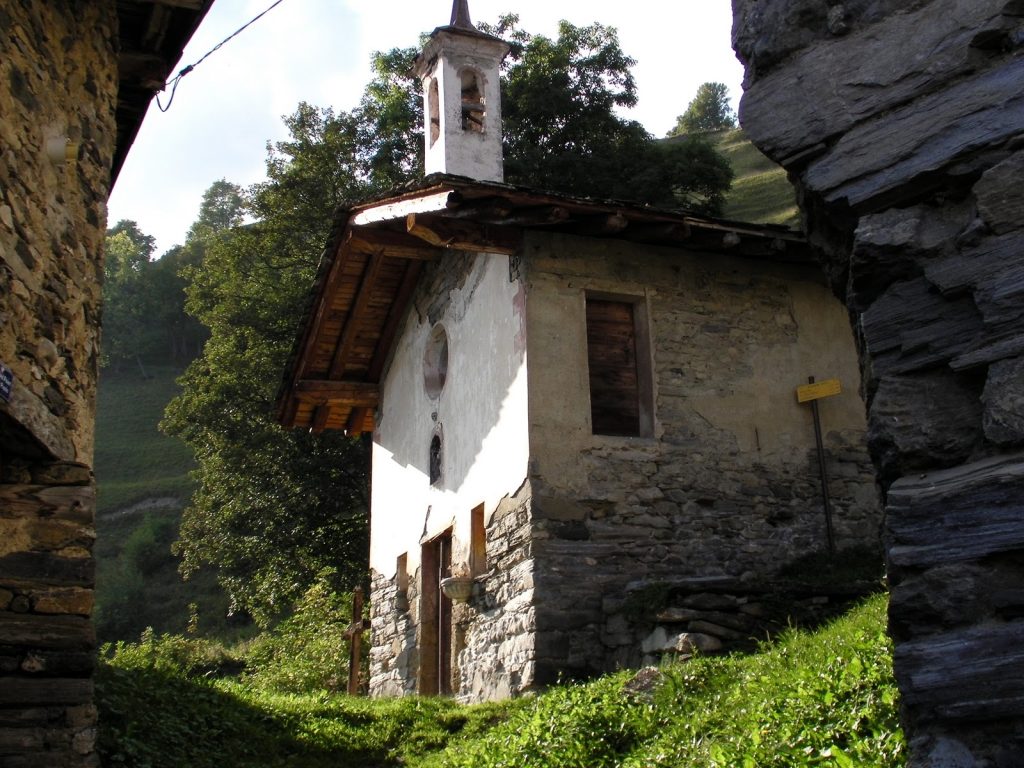Hiking just behind Bourg St Maurice in the wild gorges there are some spectacular ancient hidden trails with ancient ruined buildings. There is little sign of tourism but the environment is heavily exploited agriculturally. It’s good to see the rugged land still being used here instead of giving over to holiday homes and tourism. The short trail we took goes from Le Villaret to La Rosière then straight up, cutting below Mineurville and then up to Granville, then back mainly by the rough road.
The small chapel here is at Granville.
This bell is on another small chapel at the top of the cliff above la Rosière.
Regardless of the natural beauty of the area and the welcome sunshine and warmth, the main focus of the walk was on technique.
Power and Lightness
The main keys for climbing are to use the hip extensors and flexors, letting the leg extend fully behind. When one leg actively extends from the hip and the other flexes the combined movement is very powerful and feels light. If the focus is on the extension (glutes and hamstrings) the power can be felt and if it is on flexion (psoas) then there is a strong sensation of “lightness”. The same sensations can be felt when cycling if the coordination is correct. There must be a dual rotation at the hip and spine for this to work – the pelvis must rotate. On the bike I noticed that the motion is simplified (for awareness) if you think of allowing the “push” on the pedal to turn your navel towards the leg and foot (instead of away from it – as easily happens). If you try to propel yourself with your leg (instead of using gravity) you rotate the pelvis (spine/hip) in the wrong direction – it tends to force the hip forwards instead of letting it extend behind. The same problem happens in cycling if you try to push very powerfully.
Disequilibrium – Extraordinary Walking Sensations
The other key thing when climbing is to use both Nordic Walking poles simultaneously – keeping the hands low, not letting them go far ahead (keeping the pole/ground contact well behind). This has two functions: power is accessed in the shoulders and large upper back muscles (instead of the arm muscles) and the power is directed more upwards – which assists in overcoming the vertical work against gravity. The posture and alignment of the body being corrected in advance you should be able to focus on the efficient “falling” ahead of the Centre of Mass – so the poles are not used to try to push or pull ahead. Forward momentum still comes from exploiting the fall ahead – or disequilibrium component induced by gravity.
Descending
When descending, once again, instead of reaching ahead to land on the heel and brake – which creates a real shock on the body and a risk of slipping, extend the stride behind. This requires a very upright posture and places the work load closer to the core – to the upper leg muscles and abdomen and not the lower quads. The body is lowered down the hill with each slow extension of the hip flexor muscles – with support from the glutes and hamstrings. The poles just act as a light support ahead helping once again to reduce the vertical component of gravity but this time while the Centre of Mass is lowered instead of raised.
Wave Motion
It struck me when running (following day) that we don’t just harness gravity to fall forwards but we also exploit the upwards force against the Centre of Mass to fall forwards. The similarity to energy being transmitted in a wave seems obvious. In a water wave the water goes mainly up and down – in a circular motion. This circular motion resembles the feet when either walking, running or cycling. The Centre of Mass doesn’t go up and down – it gets “squeezed” forwards – like a surfer on a wave – or like the energy of the wave itself. When you “fall forward” with gravity and the leg extending behind the CM doesn’t lose height. Gravity is forcing the CM downwards but the elastic force of the Earth resists this though the leg, which by extending upwards deflects the CM forwards. Getting the right balance between gravity and leg force would mean a very stable and efficient CM with no up and down motion. The gravitational force is free but the upward force costs us energy. Just like the surfer we are not trying to propel ourselves forwards. When going uphill the upwards push is increased and when descending the energy goes into resisting gravity – slowing down the downwards acceleration from gravity.


